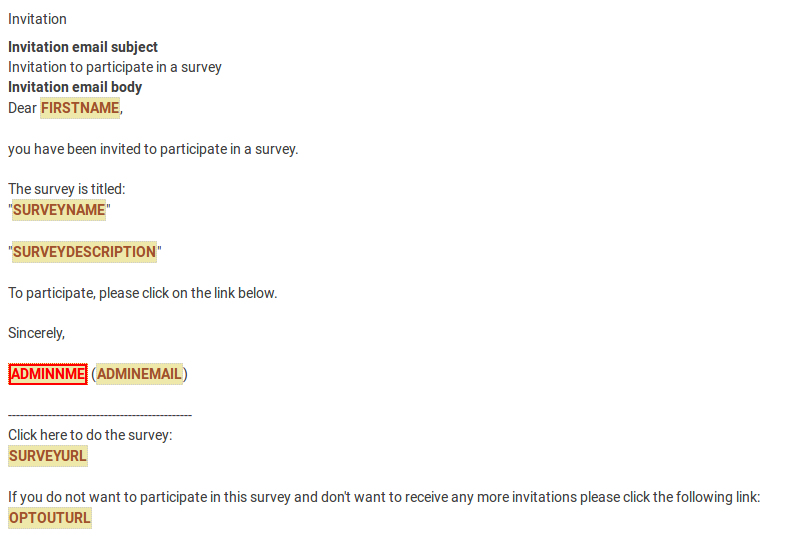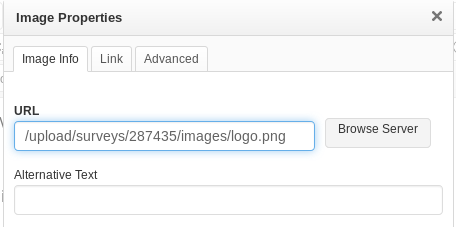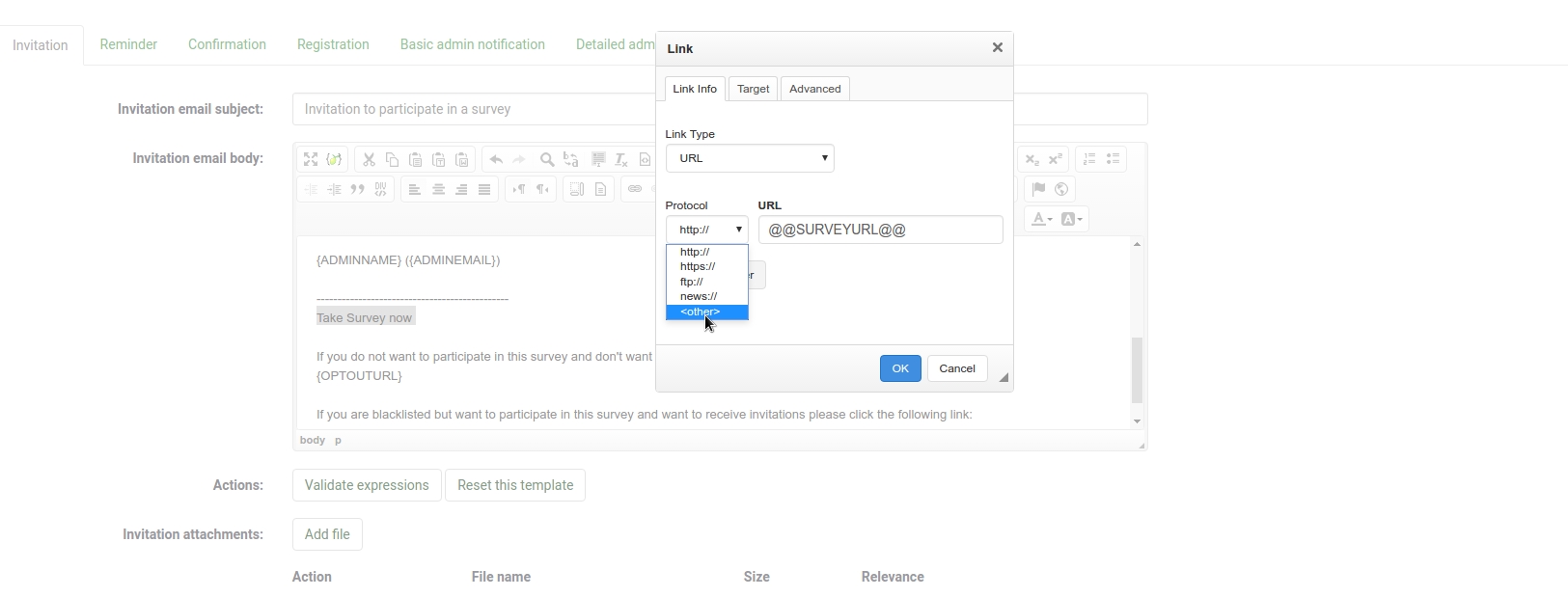Email Templates
Introduction
The email templates are used to send personalized invitations,
reminders, confirmations, and registration emails to your participants
(from the survey participants table). You can also edit the standard
basic (or detailed) admin notifications that are sent to the survey
administrators.
Email Templates: Settings > Survey menu > Email templates
Email templates panel
The email templates panel:
Five types of emails can be sent to users or admins:
- Invitation
- Reminder
- Confirmation
- Registration
- Basic & detatiled admin notifications
Invitation
This functionality is used to send emails in bulk to all survey participants in the survey participants table who have not yet received an invitation to complete your survey.
From the email templates panel, you can edit the message sent to
survey participants. To check which email placeholders can be used,
continue reading the following wiki subsection. You can also use the ExpressionScript to further customize your invitation email template.
Reminder
The Reminder functionality provides a way for survey administrators to remind the participants from the survey participants table to answer the survey.
You can edit the default format of the reminder email from the Email templates panel. To verify which email placeholders can be used, continue reading the following wiki subsection. The ExpressionScript can help you customize the text body of this email template.
Confirmation
If tokens are used and a participant fills out the survey, a
confirmation email will be sent to his/her email address. You can
deactivate this functionality from the Participant settings panel.
Click the Confirmation tab if you want to edit the email template. Check the email placeholders to see which ones can be used in this type of email. You may also use the ExpressionScript to customize your email.
Registration
If closed-access mode is enabled (there is a Survey participant table, which means that only those participants who have an allocated entry and a unique token code associated to it can complete the respective survey.
If you allow participants to publicly register for your survey, an entry in your survey participants table will be created once the respondent has submitted his or her name and email address. A script that runs in the background will automatically send the respective respondent a registration email. It contains the URL with the token that needs to be accessed by the newly registered user.
Click the registration tab to edit the format of this email. Don't forget to take a look first at which email placeholders can be used within the text body. The ExpressionScript can provide further customization to the body text you wish to use.
Basic & Detailed Admin Notifications
To get admin notifications, click the Data management
tab and type in an email address in the "Send basic admin notification
email to" field and another one (or the same) in the "Send detailed admin
notification email to" field.
By default, the only difference between the two is related to the
extra placeholder {ANSWERTABLE} that is included in the detailed admin
notification email template. This allows the user who receives these
kinds of emails to also check the submitted answers. They do not have
to access the LimeSurvey installation. However, by using the ExpressionScript and the email placeholders you can customize these two email templates.
Email templates fields
Each email template contains:
- The subject of the email: The title of the email/batch of emails you want to send;
- The email body: A text box that contains the text message you want to send to the participants. It may contain text, images, and email placeholders. The ExpressionScript can also be used to further customize the message you want to deliver;
- Email actions: Two actions are available:
- Reset this template: Once clicked, the HTML code is reset. No text is deleted;
- Validate expressions: Checks the logic of the email - whether the placeholders are correctly used or not. We highly recommend using it before sending a batch of emails. This way you can see whether the placeholders are correctly defined or not. In the below example, a small typo exists - it is emphasized in red.

Email placeholders
In the default email templates, different email placeholders are used
either in the body and/or the subject of the email. Their role is to
connect the email you want to send to each participant in your survey participants list.
The data from the survey participants table (e.g., email, first name,
last name, token, etc.) is automatically taken and put into different
unique emails before being sent to each participant from your survey
participants list.
Below are the email placeholders that can be used within the body message of your invitation and reminder email templates.
When sending out the emails, these email placeholders will be replaced
in the preview of your invitation/reminder email with data from your
survey and survey participants table.
| {ADMINEMAIL} | Email of the Survey admin |
| {ADMINNAME} | Name of Survey Admin |
| {SURVEYNAME} | Title of your survey |
| {SURVEYDESCRIPTION} | Description of your survey |
The following placeholders are allowed in invitation/reminder email templates (subject and/or body fields) and they will be replaced when sending out the emails:
| {EMAIL} | Email of the recipient |
| {FIRSTNAME} | First Name |
| {LASTNAME} | Last Name |
| {SURVEYURL} | The URL to start the survey - if you are sending HTML emails, a full URL will be displayed to the survey participant |
| @@SURVEYURL@@ | The URL to start the survey - this is the barebone link. Use this if you want to integrate the link somewhere in your custom HTML elements (available in v1.90 and later) |
| {OPTOUTURL} | The URL to deactivate sending of emails for the respective survey - a full link will be displayed in the HTML version of the email template |
| {OPTINURL} | If a participant is blacklisted and wants to participate in the respective survey, they have to click the opt-in URL to receive survey invitations/reminders again. |
| {TOKEN} | The token to access the survey |
| {USESLEFT} | The number of uses left for the token |
| {VALIDFROM} | The date the token is valid from |
| {VALIDUNTIL} | The date the token is valid until |
| {ATTRIBUTE_1} | Attribute 1 |
| {ATTRIBUTE_2} | Attribute 2 (...and so on for more attribute fields) |
If your survey is not anonymous, the email placeholders can be used to add specific entry/participant data into the Survey text elements panel (e.g., survey description, welcome message, end message).
| {TOKEN:EMAIL} | Displays the email of the participant from the survey participants table |
| {TOKEN:FIRSTNAME} | Displays the first name of the participant from the survey participants table |
| {TOKEN:LASTNAME} | Displays the last name of the participant from the survey participants table |
| {TOKEN} | Displays the token code of the participant from the survey participants table |
| {TOKEN:ATTRIBUTE_1} | Displays "Attribute 1" of the participant from the survey participants table |
| {TOKEN:ATTRIBUTE_2} | Displays "Attribute 2" of the participant from the survey participants table (and so on for more attribute fields) |
Certain placeholders can be used only within the the admin notification templates. Please note that one email per response will be sent to the email address of the administrator!
Some of the placeholders that can be used only in the admin notification panels are mentioned below:
| {VIEWRESPONSEURL} | Displays an URL that redirects you to the participant's submitted answer |
| {EDITRESPONSEURL} | Displays an URL that redirects you to a LimeSurvey page from where you can edit the responses submitted by the respective survey participant |
| {STATISTICSURL} | Click this URL to access the statistics of the survey |
| {ANSWERTABLE} | If you want to display the submitted answers of the participant in the admin notification email, use this email placeholder. This way, you no longer need to access your LimeSurvey installation in order to check the submitted answers of the respective participant (as the {VIEWRESPONSEURL} placeholder does). |
Before sending the emails, we highly recommend the validation of email templates - click the validate expressions button located under the email text body.
Participant opt-out
When you use the {OPTOUTURL} tag in your invitation/reminder
email, your participants can opt out of this particular survey by
clicking the related URL in the email - so you don't send them reminder
emails. A participant opts out of your survey will have the email
status 'OptOut' set in the survey participants list.
Barebone URL
Url placeholders have their corresponding Barebone URL. E.g., @@SURVEYURL@@ : you can use @@OPTOUTURL@@, @@OPTINURL@@ …
Using replacement function
Some specific keywords can be used within your email templates. For example, certain keywords can be used to replaces the token URL address.
The below example uses a plain link to the survey instead of a long url:
1) First, access the email templates panel and choose Invitation.2) Write the text you want to appear as a link to start the survey.3) Then select that text.

4) Add the placeholder for the plain link @@SURVEYURL@@ and choose other from the protocol-select-box.
Now, when you send out your invitation emails, the link to start the survey will be shorter.
Email attachments
File Actions
When clicking Add file the following window will be displayed asking you to choose the document from the files folder that you want to send via email:

Attachments can be added at the bottom of the email template editing interface. Please note that email attachments are uploaded on a per survey basis.
You can also upload, on the spot, a file from the desktop to your LimeSurvey installation by clicking the upload button and then selecting the file you want to attach to the respective email template.
Once selected, double click it and the file will be immediately displayed in the Files table, below the Add File button:

To have it permanently attached to the respective email template, do not forget to click the Save button located in the upper-right part of the window. To determine if an attachment should be sent on an individual basis, it is possible to add a relevance equation to each attachment.
All functions supported by the ExpressionScript can be used, as well as token attributes if the survey uses tokens. With notification or confirmation templates, it is also possible to use question codes used in the survey. If you want to delete a file, click the red trash button located under the Action column and save the changes.
- When a file can not be found on the file system, the email will be sent without an attachment.
- Exporting/importing a survey does not export/import the attached uploaded files. However, the settings for attachments will be maintained, as well as the relevance equations.
Image attachment
You can attach an image/images if you send HTML emails. To do this, you need to update the URL source of the image by settings its path to your public directory of your LimeSurvey instance.

Related Articles
Notifications & Data
Notifications & data To save response-related details to the responses tables, access this panel. You can save the referrer URL, IP address, timings, etc. that can help you produce more in-depth analyses. LimeSurvey allows you to use the tracking ID ...General Settings
General Survey Settings The general settings of a survey allow the user to edit basic survey information such as the survey owner, administrator's email, and the template used in the survey. From the Settings tab, under Survey settings, select ...Overview - SETTINGS
Overview - SETTINGS Survey settings and Survey menu are located under the Settings tab. Survey settings The items under Survey settings allow users to edit different survey-related settings. The following are the Survey settings. Click each of the ...Overview - Survey Menu
Survey menu Under the Settings tab, you will find Survey settings and Survey menu. The following will cover the Survey menu. The following are settings under Survey menu and a brief explanation of each: Question list Group list Reorder ...Survey Participants
Overview The Survey Participants functionality allows you to invite a group of people to participate in your survey, keep track of who has completed the survey, and ensure that each person can only participate once. The survey participants table ...
